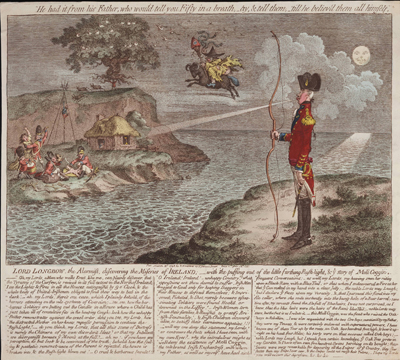Lord Longbow, the Alarmist. . .
This is the second of two attempts by Gillray to provide an accompanying print and illustration for "The Ode to Lord Moira," a rather odd little poem appearing in the new government publication, The Anti-Jacobin, or Weekly Examiner for which Gillray had been hired to provide graphic support. The intent was to satirize Lord Moira for daring to criticize the repressive governmental policies in Ireland and for allowing himself to be considered as a possible Prime Minister. Gillray's first attempt was likely the unfinished and unpublished print in the British Museum titled "Ode to Lord Moira."

©Lewis Walpole Library, Yale University
The full title of this print is Lord Longbow, the Alarmist, Discovering the Miseries of Ireland with the puffing out of the little farthing Rush-Light, and ye story of Moll Coggin. The print was a reaction to several speeches in 1797/98 by the Irish-born Lord Moira, criticizing the treatment of the Irish by the Anglo-Irish government. His point was that arbitrary and repressive measures carried out in Ireland in the name of preserving order were in fact the worst way of ensuring the much needed support of the Irish against threats from France. Indeed, he argued, such harsh measures would eventually lead to further discontent and indeed open rebellion.
As the title and some parts of the lengthy caption below the image suggest, the official response was to view Moira as an "alarmist," and his accounts of the abuses in Ireland as just so many fabrications—the virtual equivalent of the tall tales about Moll Coggins the Irish-Enchantress, about swans perched in trees, and about tenants with supernatural powers, carrying oak trees upon their heads.
But Gillray's print is neither a faithful illustration of the "Ode to Lord Moira" (see the link below for the full text of the Ode) nor even a complete and accurate rendering of its caption. In both the poem and caption, for instance, it is the troops who blow out the tapers of the Irish cottagers. In the print, it is Moira himself who seems to be directing a blast at the candle in the window. In the Ode, the actions are committed against "infant thousands." In the caption, to the print, the victims include both children and adults:
. . . look how the unhappy / Father remonstrates against the cruel order,/ don't you see my Lords, how the distracted Mother on her knees requests permission to continue the Rush Light
Actions included in the caption do not appear in the print and elements of the print (such as the woman being hung and stretched next to the house) do not appear in the caption. The Ode speaks of Moira drawing his bow, but in the print his bow is clearly unstrung. There are disconnects everywhere you look. Even the moon seems displaced. It should be positioned below the cloud and aligned with the track on the water leading to Moira. But instead it smiles down from above the clouds with no indication of the radiance that would create such a track on the water. Such glaring inconsistencies are unusual in Gillray who is usually fastidious, especially when it comes to the image itself.
We know that Lord Longbow is based upon a drawing by an amateur (which is, as yet undigitized, and which I have not seen). If, as I suspect, Gillray had already created a far more interesting and accurate print ("The Ode to Lord Moira") which was rejected, and if he was now given an amateur drawing to serve as his model, he may have felt justifiably insulted. The disconnections in the print, then, may reflect Gillray's disconnection from the endeavor. He had for this print gone beyond caring.
Sources and Reading
- Commentary from the British Museum on Lord Longbow, the Alarmist. . .
- Draper Hill, Mr. Gillray The Caricaturist, 1965, p.70, Pl. 67.
- "Earl of Moira," Wikipedia
- "Irish Rebellion of 1798," Wikipedia
- "The Anti-Jacobin," Wikipedia
- Thomas Wright and R.H. Evans, Historical and Descriptive Account of the Caricatures of James Gillray #182
- Ode to Lord Moira: Complete Text
Comments & Corrections
NOTE: Comments and/or corrections are always appreciated. To make that easier, I have included a form below that you can use. I promise never to share any of the info provided without your express permission.